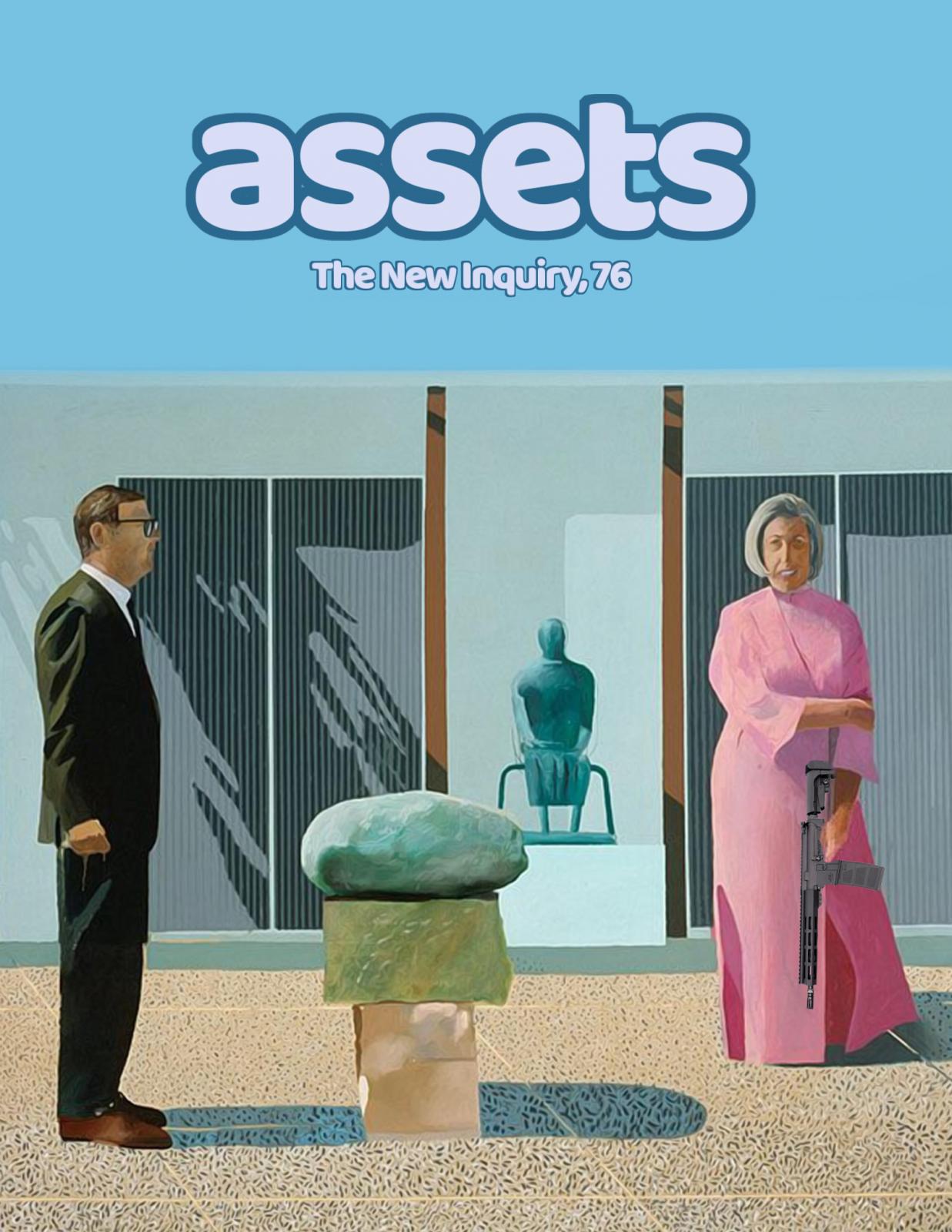New Masses
Editors' Note
On the speed of unrest: “The public is a slow-moving riot,” writes philosopher Nina Power in “Thirty-One Theses on the Problem of the Public,” quoted in the chapter of Joshua Clover’s Riot. Strike. Riot that we excerpt in this issue. But this is also a way to explain the school-shooting epidemic, in New Yorker writer Malcolm Gladwell’s hands: “think of it as a slow-motion, ever-evolving riot.” As usual, the apologist of ruling-class ideology unwittingly expresses a facet of the truth. The public as we know it is a formal name for a long series of shooting sprees carried out by young white men, or, put another way: bourgeois society is war.
Within the theater of war are populations and zones marked as targets, and those who enjoy the protection of a sort of social camouflage. Riot. Strike. Riot concerns itself with the population “whose labor can never be objectified,” and therefore “whose modality is riot,” and whose unfolding is “not a demand but a civil war.” Clover notes that researchers from the Global Social Protest Research Group have found that the wave of uprisings since 2011are neither “Marx-type” or “Polanyi-type,” but a new form entirely: “Protest of the Stagnant Relative Surplus Population.”
We may think we know what these surplus populations look like. The intuitive relation of race and riot (Clover writes: “we might finally argue that the term “race riot” has an inverted sense: not that of race as cause of riot, but of riot as part of the ongoing process of racialization. It is not that race makes riots but that riots make race.”) informs one aspect of of this population. But visibility and invisibility are both weapons at work in this war.
“Narratives around various forms of state violence tend to be gendered male,” Zoe Samudzi writes in this issue. Because of this, “Black revolutionary energies in the past have deliberately excluded and discriminated against cisgender women as well as queer and transgender individuals. And, sadly, they continue to do so.” Drawing lessons from the movements that used the #RhodesMustFall, #SayHerName and #ImbokodoLead hashtags, she calls for a black liberation politics that places queer, transgender, disabled, poor, and other marginal black identities at the center. Nanjala Nyabola, too, calls for an enriched political understanding of how to relate to these violent global abstractions in her essay “Long Live Man-Africanism.” She upbraids the patriarchs who have distorted the revolutionary potential of pan-Africanism into solidarity for the wealthy men whose power dominates Africa today. Man-Africanism has “never seen the liberation of women as a priority,” she writes, because “the oppression of women has never seemed as grave or as urgent as the suffering of powerful men. Focused on formal power and the public sphere, it will never seek to overturn private hierarchies of exploitation if the primary beneficiaries will be women.” But the visibility of suffering can also be a way of invisibilizing the global hierarchy of humanness that long-distance exploration relies on. In “The Bengali Click Farmer,” Mayukh Sen reads a recent documentary as one entry in a recent tradition of Western pity for Bangladeshi workers that ultimately does more for the pitiers than any of the workers they invoke. The documentary, focusing on click farms providing thousands of likes for Facebook pages with a social media budget, relies on the same colonial relation that it purports to examine: Bangladeshis are emptied of any emotive capacity of their own, only to serve as a foil against which Western feelings are measured as more valuable and more real — “to do the emotional work necessary for the Western consumer to be moved, and to have that consumer’s beliefs stroked rather than complicated.” For now, global wage disparities make automating service work like this cheaper to conduct with real humans overseas. But the smart homes of the future aim to extract more value from the other end of the market. Ava Kofman investigates the Internet of Things-enabled household to come and finds that it still rests on a foundation of intricate domestic care work. This replacement of low-wage but highly skilled labor by machines is the mark of a failure to reimagine social relations. Instead of living inside of the enemy’s weaponry, we could recognize the nuclear family as an artifact of a defunct moment in history and redistribute reproductive labor. Perhaps we will, but for now the future looks like an industrially-designed house. Design, Erwin Montgomery writes, “like fascism, leads people to misunderstand the fundamental verities of their existence.” By making manual labor that has been reduced to mere gesture more visible than the generic, the modern cult of design offers consumers the opportunity to express themselves as expert consumers. But instead of a democratization of aesthetics, the extension of design into more corners of daily life represents a distributed network of power, an inverted military bureaucracy, keeping constant tabs on its captives and combatants alike. An indelible image of what American fascism looks like appeared on social media last winter, when Black Lives Matter organizers brought crowds into the Mall of America and an enormous screen, clearly intended for the lush hues of commercial videos, instead displayed a black and white warning to disperse or face arrest. In this issue, Erik Forman, a worker who had spent years trying to organize his Starbucks shop there tells the story of how he and his fellow organizers greeted the movement as the signal of a different kind of unionism. “Black workers are leading, white workers need to follow,” Forman writes. The difficulties of unionizing in the classic mode are a function of a labor market shaped by a historically different relation to capital. The specifics are detailed in the excerpt of Clover’s book, but the felt experience is chronicled in the universally-reviled 2015 Zac Efron flop We Are Your Friends, dissected here by Ayesha Siddiqi. This limp saga of a crew of boy EDM DJs is “the perfect conclusion to anachronistic first wave millennial angst and Pitchfork-era debates,” she writes. Had it been girls, however, the movie couldn’t have been so earnest. Alana Massey writes about the way that the idea of the clique is used to curtail female intimacy in adulthood. Its visibility is in excess of its prevalence, she argues, and is a public check against women acting in solidarity. The expectation that women be ready to perform friendship for everybody “signals that a woman’s social life is not considered her own,” Massey writes. “It must be arranged for the benefit of the family, of strangers, anyone really besides herself.” In “The Silence of the Masses Might Be Social Media,” Rob Horning considers the implications of social media through Baudrillard’s gnomic writing on the “masses.” These abstract publics undergo a paradoxical inversion. “For Baudrillard,” Horning writes, “deindividuated populations ruled over through monitoring, statistical modeling, and predictive analytics are supposed to be “the social”—i.e. the “reality” of what the data measures, but they instead are becoming “the masses,” an amorphous blob of individuals that eludes certain management by its sheer inertia, which proves uninterpretable even as the system throws more resources at trying to understand what it wants or where it is headed.” Is this elusive mass related to the “Stagnant Relative Surplus Population” of Riot. Strike. Riot? The parallels are striking, and it’s certainly the case that these increasingly non incorporable populations are the province of management, statistical capture, and prediction. The population of social media and the population of the riot don’t strictly coincide, but there is something satisfying about their shared emptying communication “itself of meaning through the intensification of the means by which it is circulated.” That is: speeding up the publics of social media, until it becomes a real-time riot.
Featuring
-
The New Inquiry Vol. 52: New Masses
-
Surplus Rebellions
-
Our Brand Could Be Your Crisis
-
Eulogy For Pan-Africanism: Long Live Man-Africanism
-
The Clique Imaginary
-
The Black Movement to Come
-
Bad Housekeeping
-
Design Is a Bureaucrat
-
Making Black Lives Matter in the Mall of America
-
The Bengali Click Farmer





